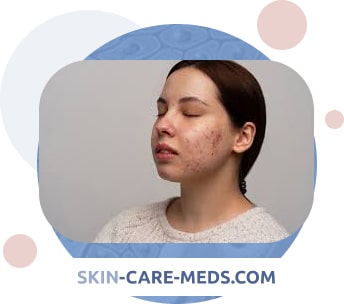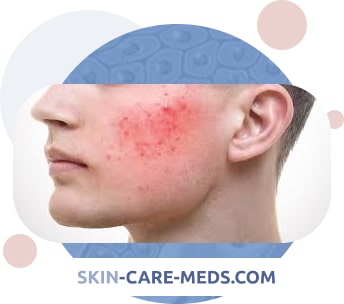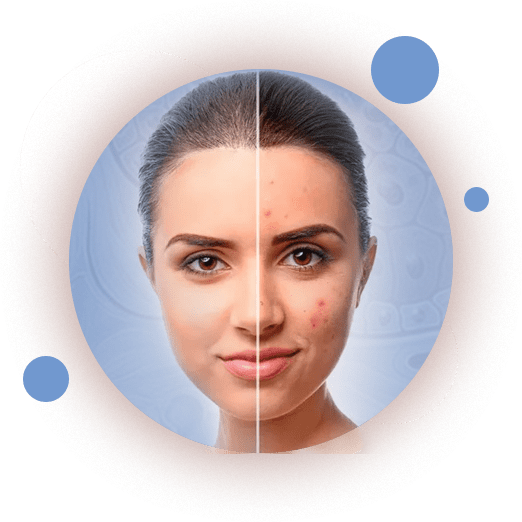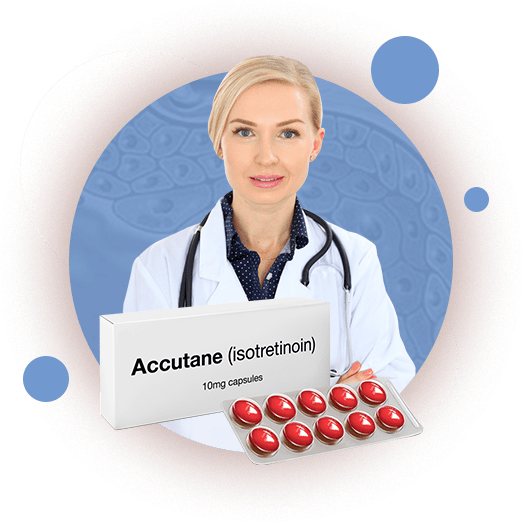

What is acne?
Acne (acne, acne) is a serious inflammatory skin disease that occurs due to the accumulation of excess sebum in the mouths of the hair canals. This leads to the formation of the so-called "plug", which creates an ideal environment for the growth of bacteria, the appearance of inflammation on the skin, rashes and other imperfections.
What does acne look like?
Acne on the face can manifest itself in different ways, depending on the severity and degree of neglect of inflammatory processes. It can be blackheads, red acne, purulent painful rashes, whiteheads. In most cases, rashes affect the T-zone - the area with the greatest activity of the sebaceous glands and the most enlarged pores. These are the forehead, nose and chin. In the U-zone (cheeks and cheekbones), acne appears less frequently.
Types and stages of acne
Dermatologists distinguish several separate types of acne, which differ in symptoms and external manifestations:
- Closed comedones (aka subcutaneous acne) are rashes consisting of compacted and inflamed skin secretions (mostly black or gray). They are located under the skin and are formed as a result of the oxidative reaction of the contents with oxygen.
- Open comedones (better known as blackheads) - have the same nature as closed, but appear exclusively on the surface of the skin.
- Nodules are subcutaneous nodules that are accompanied by inflammation and pain. They are hard to the touch and feel like hard bumps on palpation. In some cases, they may be surrounded by purulent discharge.
- Papules are painful small pimples of red color that do not have purulent content.
- Pustules are clearly visible ("classic") acne. Accompanied by purulent discharge and a pronounced inflamed area of red skin.
The stages of acne development can be divided into:
- Mild form - there is an oily sheen, black and white non-inflammatory acne.
- Moderate severity - oily sheen becomes more intense, a lot of black and white blackheads, red inflammatory rashes (from 10 to 20 elements).
- Moderate form (expressed in the formation of a large number of comedones and 10-20 acne with signs of inflammation).
- Severe acne (more than 40 elements), large and painful nodes, pustules and cysts, constant inflammatory processes.

Causes of acne on the face
To one degree or another, about 80% of people have experienced acne at least once in their lives. Let's analyze the possible factors of acne, which provoke hyperactivity of sebum synthesis and the appearance of inflammatory foci.
TOP 13 causes of acne on the face:
- changes in the hormonal system or fluctuations in hormonal levels (puberty, certain phases of the cycle, pregnancy);
- diseases of the gastrointestinal tract, thyroid gland;
- unbalanced diet, frequent lack of sleep, bad habits;
- improper care;
- demodicosis (acne mite);
- the use of anabolic steroids;
- the use of drugs containing halogens and barbiturates;
- skin lesions accompanied by inflammation;
- intensive reproduction of acne bacteria on the surface of the skin (Propionibacterium acnes or Malassezia), which provoke the appearance of inflammatory foci;
- thickening of the stratum corneum of the epidermis (hyperkeratosis);
- accumulation in the pores of keratinized particles of the epidermis, mixed with sebum;
- violation of hygiene rules;
- Stress: The stress hormone cortisol, produced by the adrenal glands during emotional turmoil, activates the sebaceous glands.
Acne treatment
Acne is a serious disease, and it must be treated under the supervision of a dermatologist. If the problem is limited to a couple of acne (comedones, pustules) and clogged pores, you can solve it yourself with the help of dermatocosmetics.
If the situation is serious, cystic inflammations, deep subcutaneous acne (nodules) or nodular acne appear, in this case it is better to consult a specialist. He will help prescribe medication, including, among other things, antibiotics, hormonal drugs, as well as drugs with isotretinoin. Under such circumstances, self-medication can only exacerbate the problem.
Do I need acne treatment?
Acne marks and pimples on the face and body can make a person's life uncomfortable, they deprive self-confidence and create psychological problems in communication. At some point, a person despairs of waiting until "everything will go away by itself" and decides to treat acne correctly, that is, he makes an appointment with a dermatologist. The first question that almost all patients ask is how soon you can get rid of acne. We addressed it to a dermatologist with many years of experience, Philippe Beaulieu.
All my patients impatiently and hopefully ask when acne will go away ... The answer directly depends on the cause of acne and whether the patient is ready to follow all the recommendations of the dermatologist. It is important to understand that if acne is left untreated, the disease can last for years.
How to treat acne correctly?
Young people are especially likely to suffer from acne - approximately 80% of adolescents face the problem of acne. Dr. Philippe Beaulieu also notes that with age, the problem does not solve itself:
Acne is not just a teenage problem. This disease occurs in 40% of adults, especially for a long time acne can occur in women. About a third of adult women suffer from acne, especially often relapses occur at certain periods of the cycle. And sometimes rashes occur even in children.
What methods can be used to get rid of acne:
- ExfoliationExfoliation of the stratum corneum of cells and intensive cleansing of the skin at a deeper level with scrubs, peels, gommages, masks. The frequency of procedures depends on the type and condition of the skin.
- Pharmacy cosmetics have a bacterial effect on the epidermis, slowing down the rate of development of propionic bacteria, which contribute to the development of new imperfections, dry existing rashes and reduce the production of sebum. The composition of such funds includes active ingredients in high concentrations, allowing you to comprehensively deal with the problem of rashes.
- AntibioticsFor the treatment of stage 3 and 4 acne (moderate and severe), a dermatologist prescribes systemic antibiotics: minocycline, doxycycline, tetracycline and erythromycin.
- Hormone therapyFor the treatment of acne in adulthood caused by hormonal imbalance in the body, a dermatologist prescribes appropriate tests and hormone therapy.
- Retinoids. With regular use, vitamin A derivatives aimed at normalizing skin cell renewal effectively fight acne and post-acne (scars and hyperpigmentation), evening out skin tone and relief, accelerate the exfoliation of dead skin cells.
- PhototherapyAcne treatment with phototherapy (radiation) is based on exposing problem areas of the skin to an intense stream of light, while reducing the production of sebum. The procedure also improves blood circulation in the sebaceous glands, which contributes to reparative processes.
How long do acne last?
The speed of getting rid of acne directly depends on how quickly you begin to take a comprehensive approach to treatment. Discipline in diet and daily hygiene is very important, as well as strict adherence to the recommendations of a dermatologist on the use of medicines and cosmetics for skin care.
It is impossible to unequivocally answer the question of how long acne is treated. Even if acne appears quickly and suddenly, the skin needs time to start responding to treatment. If everything is done correctly, positive dynamics can be noticeable in a month. A mild form of acne (I and II degree), as a rule, does not require medical treatment and in most cases it is possible to get rid of the disease in 6 to 12 weeks.
What happens if you do not treat acne of 2-3 degrees?
If you relax and instead of being treated on the recommendation of a dermatologist, simply squeeze out acne or mask it with cosmetics, the problem can last for many months. With moderate and severe acne (III and IV degrees), complex therapy and drug treatment are required, which at this stage of the disease can last up to a year.
Possible complications and consequences
Advanced stages of acne rarely pass without a trace. According to recent studies, 95% of people after improper treatment of acne have post-acne - stagnant multi-colored spots on the skin, scars and bumps, irregularities in areas with the most severe inflammation.
This means that after acne, the skin can lose a beautiful healthy appearance due to imperfections that have appeared:
- Enlarged pores
- Red, blue and even purple traces
- Scars and irregularities
- Cysts of the sebaceous glands
- White eels
- Brown spots
- Post-inflammatory hyperpigmentation
- Overdried sensitive skin
- Peeling of the skin
The severity of the complications that appear depends on how badly the skin was affected. For example, the appearance of hyperpigmentation indicates skin injury at the level of the epidermis. And scars and skin irregularities are the result of damage to the dermal layers of tissue.
How to care for acne skin?
Acne skin needs gentle delicate cleansing, regular effective moisturizing and timely suppression of emerging foci of new inflammation. Proper care significantly speeds up acne treatment and reduces the likelihood of scars and spots on the skin.
Comprehensive acne skin care can be divided into 3 main stages:
- 1Cleansing - removal of dead dermis, skin impurities, excess fat
- Moistening
- Revitalization and soothing care for inflamed skin
 DE
DE FR
FR IT
IT ES
ES






